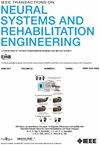The Multi-Frequency Decomposition Entropy Learning for Nonlinear fMRI Data Analysis
IF 4.8
2区 医学
Q2 ENGINEERING, BIOMEDICAL
IEEE Transactions on Neural Systems and Rehabilitation Engineering
Pub Date : 2024-12-11
DOI:10.1109/TNSRE.2024.3515168
引用次数: 0
Abstract
Functional magnetic resonance imaging (fMRI) have been widely adopted to explore the underlying neural mechanisms between psychiatric disorders which share common neurobiology and clinical manifestations. However, the existing studies mainly focus on linear relationships and ignore nonlinear contributions. To address the above issues, we propose a new method named multi-frequency decomposition entropy (MDE) learning for inferring nonlinear functional connectivity between brain regions. Firstly, the variational mode decomposition was used to divide fMRI data into five groups of frequency. Next, the copula entropy was used to calculate the nonlinear relationship between brain regions in each frequency group, and then the best important nonlinear relationships were screen out by using statistical t-test. Lastly, a gyrus importance index was proposed to reflect the distribution trend of gyri in different frequency groups. The results of applying MDE for the fMRI data analysis of schizophrenia, bipolar disorder, and attention-deficit hyperactivity disorder showed that the difference between the three groups of patient and healthy control is large at the hub nodes, and the nonlinear relationship between the patient groups is weak when they are at the same hub node. In addition, each disease exhibits unique characteristics compared with other diseases and healthy control. In a word, the nonlinear functional connectivity of different frequency groups reflect the differences and commonalities between diseases and reveal possible discriminating biomarkers among mental diseases.非线性fMRI数据分析的多频分解熵学习
功能磁共振成像(fMRI)已被广泛应用于探索具有共同神经生物学和临床表现的精神疾病之间的潜在神经机制。然而,现有的研究主要集中在线性关系上,而忽略了非线性的贡献。为了解决上述问题,我们提出了一种新的多频分解熵(MDE)学习方法来推断大脑区域之间的非线性功能连接。首先,采用变分模态分解方法将fMRI数据划分为5组频率;其次,利用copula熵计算各频率组脑区之间的非线性关系,然后利用统计t检验筛选出最重要的非线性关系。最后,提出了反映不同频率组脑回分布趋势的脑回重要性指数。将MDE应用于精神分裂症、双相情感障碍和注意缺陷多动障碍的fMRI数据分析结果显示,三组患者与健康对照组在枢纽节点处差异较大,且在同一枢纽节点时,患者组间的非线性关系较弱。此外,与其他疾病和健康控制相比,每种疾病都表现出独特的特征。总之,不同频率组的非线性功能连通性反映了疾病之间的差异和共性,揭示了精神疾病之间可能的区别性生物标志物。
本文章由计算机程序翻译,如有差异,请以英文原文为准。
求助全文
约1分钟内获得全文
求助全文
来源期刊
CiteScore
8.60
自引率
8.20%
发文量
479
审稿时长
6-12 weeks
期刊介绍:
Rehabilitative and neural aspects of biomedical engineering, including functional electrical stimulation, acoustic dynamics, human performance measurement and analysis, nerve stimulation, electromyography, motor control and stimulation; and hardware and software applications for rehabilitation engineering and assistive devices.

 求助内容:
求助内容: 应助结果提醒方式:
应助结果提醒方式:


